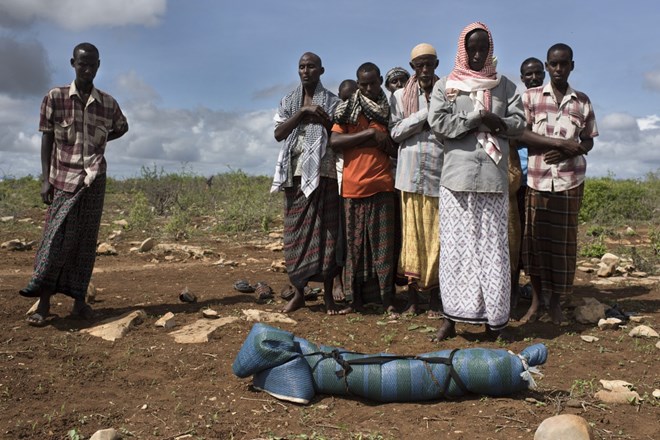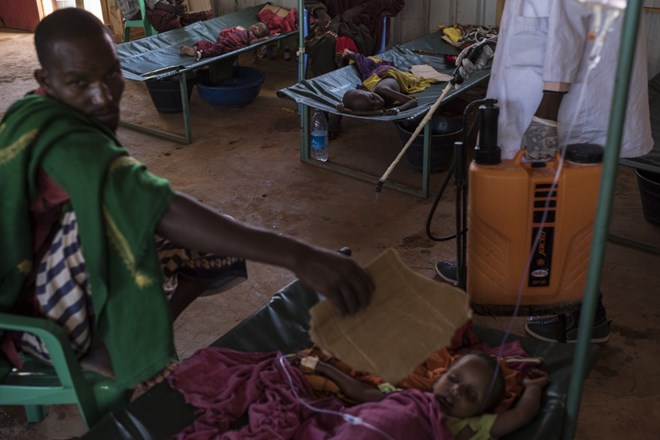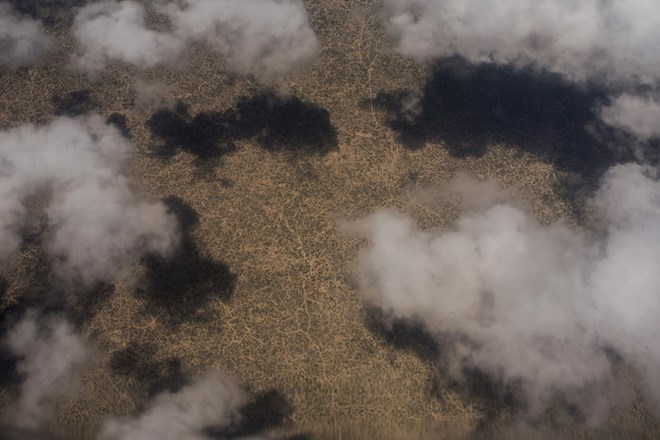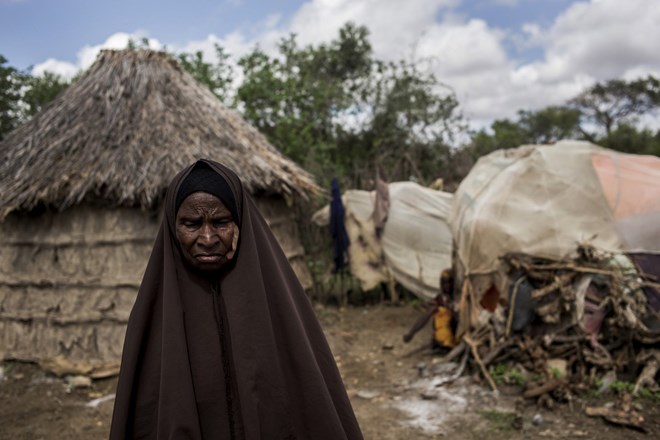
Wednesday May 24, 2017
By Max Bearak

Bashir Bille, 40, looks at the body of his son, Noor, 4, as men pray before burying him at a camp for displaced people in Baidoa, Somalia. Noor died from complications from cholera, and this was the third burial of the morning. (Andrew Renneisen/For The Washington Post)
BAIDOA, Somalia — Aftin Noor stepped back from the tiny graves he’d been digging and surveyed his work. Exhausted, he turned his palms skyward, squinting into the relentless midday sun, and asked God for an answer.
“I dug three children’s graves this morning,” said Noor, his voice cracking, his undershirt soaked with sweat. “And I have dug 20 or more this month. Why?”
The immediate answer is cholera. The waterborne disease is sweeping through this city’s sprawling refugee camps, which are filled with people driven from their villages by a vicious drought. Spotty, tantalizing rain showers have left fetid puddles, speeding the infection’s spread. Like a desperate predator, cholera often picks off the weakest targets: children.
The drought and the looming specter of a famine have brought nearly 160,000 people to Baidoa from the baked countryside. They have come to save themselves from almost certain starvation. But an outbreak of cholera is spreading death through this place of refuge.
The exodus to Baidoa began last November when stores of food began to run out following two years of limited rains. More than 55,000 people arrived in April alone. Whole villages have relocated here.
Somalia is no stranger to famine. Between late 2010 and early 2012, about 260,000 people perished, mostly around Baidoa, about 120 miles northwest of Mogadishu. Then, as now, the militant Islamist group al-Shabab, which controls almost all rural southwestern Somalia and is hostile to aid agencies, made it nearly impossible for lifesaving food and water to be delivered anywhere but to the few cities under government control.
Baidoa was al-Shabab territory then. People starved while walking from their homes near here to camps in the distant capital Mogadishu, or in neighboring Kenya and Ethiopia. Now Baidoa is an island of government control. Aid agencies have established a presence here.
Half of Somalia’s population, or roughly 6 million people, are now dependent on humanitarian aid. The United Nations and a constellation of international and local aid agencies and donors believe they are better prepared to address the crisis. Most think 2017 will not mirror 2011, even if the rains fail again.
But the rapid coalescence of squalid camps has complicated the picture. More than 20,000 cases of cholera or related waterborne illnesses have been registered in the Baidoa region since January. Unlike the giant U.N. camps in, say, Jordan or South Sudan, Baidoa’s are new and not directly U.N.-administered, with the displaced responsible for building their own shelters and buying their own food, mostly with cash they receive from international aid groups. The camps have sprung up on vacant land owned by locals. In that vacuum, sanitation facilities fell behind more immediate needs — like getting food — and now aid workers are trying to stay ahead of the outbreak’s curve.

A worker sanitizes a cholera treatment center at the Bay Regional Hospital in Baidoa. The Bay region of Somalia in which Baidoa is located has seen the highest number of cases of cholera this year. (Andrew Renneisen/For The Washington Post)
“We are trying to negotiate with the landowners to allow us to build pit latrines, but some of them are being stubborn,” said Peter de Clercq, who oversees the U.N.’s humanitarian mission in Somalia. Cholera, which is endemic in Somalia, spreads quickly in places where people defecate in the open, and the waste ends up in food or drinking water.
The Tawwakul 2 Diinsoor camp is one of a group of camps for displaced people around Baidoa that are home to more than 155,000 people, according to the U.N. refugee agency. (Andrew Renneisen/For The Washington Post)
Osman Hasan Yare, approximately 70, is looked after by a relative at the Tawwakul 2 Diinsoor camp. Yare came to the camp with his family two months ago due to the drought and is suffering from what his relatives believe to be a urinary infection. (Andrew Renneisen/For The Washington Post)
“There is still a significant advantage to being in the camps. People can access cholera treatment centers at hospitals. Cholera is easily treatable — it is a matter of catching it before it is too late,” said de Clercq. “From what we know, [you are] four-and-half times more likely to die from cholera if you live in an al-Shabab-controlled area.”
Around 200 deaths from cholera and related diseases have been recorded in or near Baidoa, but aid workers caution that the toll in al-Shabab-controlled areas might be 10 or more times higher.
Bashir Bille, 40, witnessed cholera’s terror in his village. In just a few hours, a body already weakened by hunger could lose all its water, effectively drying out from the inside.
When Noor, Bille’s 4-year-old son, developed incessant diarrhea sometime after his family arrived in Baidoa two months ago, the father quickly sent the boy to the Bay Regional Hospital.
Noor was a symbol of hope for Bille’s family. During the last famine, in 2011, they had fled with hundreds of thousands of others to the Dadaab refugee camp in Kenya. They returned to their village near the town of Qansax Dheere only when they heard rains had fallen in 2013.

The landscape near Baidoa as seen from the air on May 11. (Andrew Renneisen/For The Washington Post)
They had survived, amid so much death. Bille’s wife, Oorow Madsheikh, gave birth to Noor.
He was admitted to the hospital in Baidoa during a time of growing alarm. The patient ledger at the cholera ward had started off with neat, single-spaced names, but after a bout of rain hit the camps, its pages became crowded, disorganized.
Oral rehydration salts strengthened Noor enough for the hospital to release him after a few days. But a week later, on a Saturday morning in mid-May, he suddenly relapsed. He died in an hour.
Two of his brothers are hospitalized with cholera symptoms.
“I don’t know exactly how they got sick,” said their ashen-faced father, staring blankly ahead as Aftin Noor and his team of diggers took turns with a shovel and a pick ax, excavating Noor’s two-by-one-foot grave. The diggers were from Bille’s village — everyone from there was here now. “Children run around. They touch things. They suck their fingers. We can’t watch them all the time.”
UNICEF says that more than 275,000 children across Somalia are facing severe malnutrition, making them nine times more likely to die of diseases including cholera or measles. In Baidoa, 72 percent of households in the camps have a child younger than 5, according to the United Nations.
The local hospital, which gets support from aid groups, has certainly saved many lives. But some people are not comfortable sending their children there, believing instead in traditional medicine. When Faduma Abdirahman’s six grandchildren, entrusted to her by her daughter, fell ill in a camp in Baidoa, she decided to return to her starving village about six miles away rather than have them admitted.
It had taken only a week in the camp for two of the children to develop uncontrollable diarrhea, and the four others to fall prey to a less widespread outbreak of measles.

Faduma Abdirahman, 50, stands outside her home in the village of Rebey, Somalia. She was taking care of her daughter’s six children, who all died — four from measles, two from cholera. (Andrew Renneisen/For The Washington Post)
Abdirahman, 50, can barely speak now, her face frozen in an expression of unimaginable sorrow. “I tried to save them by bringing them back to the village,” she whispered, her gaze on the scorched ground outside her home. “I didn’t know what else to do. They all died.”
The only lasting respite from the drought will come in the form of rain. The season, which usually starts in April, is off to an uneven start. From a plane, one can see parched, sandy stream beds intersect with timeworn footpaths, giving the land the cracked look of dry skin.
Noor’s body was brought to its resting place in that cracked land wrapped in a white shroud, which was in turn wrapped in a blue tarp. Aid agencies recommend double-wrapping for cholera victims. Noor was thus deprived of the traditional Islamic pre-burial cleansing, but a group of men still gathered to murmur his last rites.
With a final “God is Great,” the men lowered the boy into the earth, covering his body first in wet mud, then flat rocks, then dirt, but it was not enough to fill the grave. Only by skimming some soil off the top of another grave, dug that same morning, did they manage to fill it.